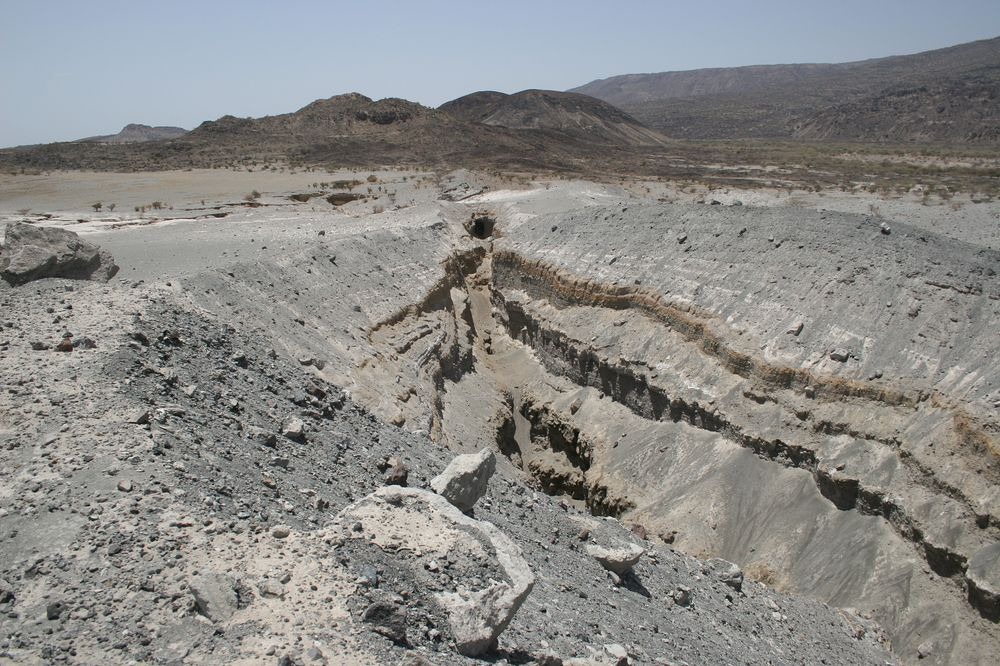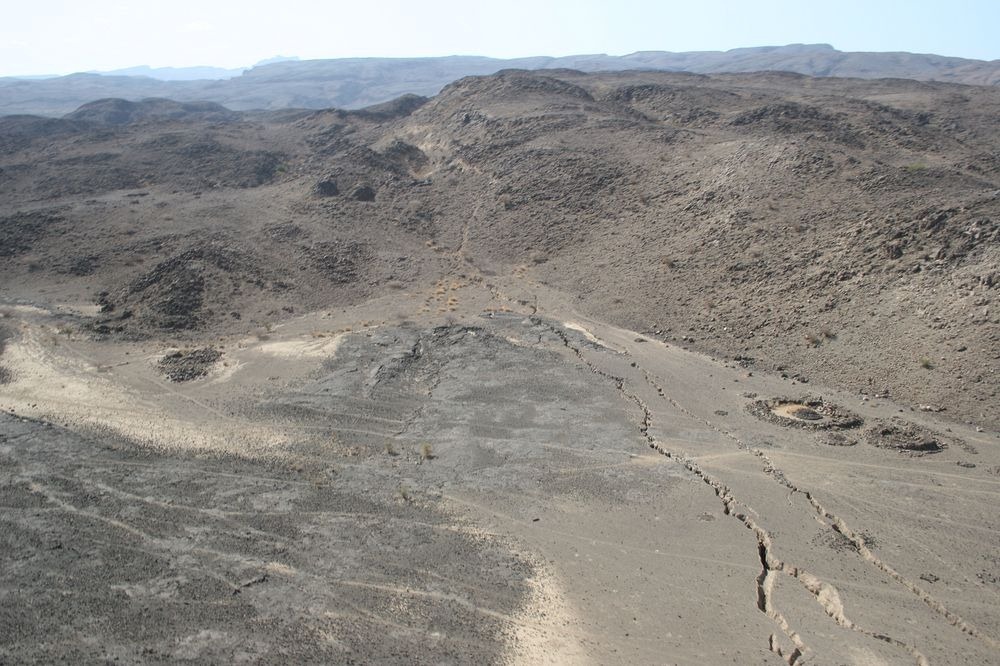In the remote Afar depression in northern Ethiopia, the African Continent is slowly splitting apart and a new ocean is forming. Normally geological processes such as the formation of rivers, seas and mountains is a painfully slow process, but in the Afar Triangle near the Horn of Africa, this is happening at a staggering rate.
In 2005, an eruption at the Dabbahu volcano followed by a period of intense seismic activity started a crack on the earth’s crust that rapidly propagated south like a zipper opening. The fissure was 60 km long and 8 meters wide, while the ground between them sank by 2 meter. All this happened in a matter of days. Over the course of the next few months, hundreds of crevices were seen splitting in the desert floor and the ground slumped by as much as 100 meters. At the same time, scientists observed magma rising from deep below as it began to form what will eventually become a basalt ocean floor.

A 500-meters long volcanic vent that opened on September 26, 2006. Photo credit: Julie Rowland, University of Auckland.
Thirty million years ago, Africa was one big plate but then a gigantic stream of molten rock rose from beneath the Earth's crust and began slicing through the African continental plate separating the Arabian Peninsula from Africa and created the Red Sea. Today, there are not two but three separate plates that meet at what is known as the Afar Triple Junction. These plates are the Arabian, Somalian, and the African. All the three plates are moving away from each other at a speed of roughly one centimeter per year. Eventually, when the crack between the Arabian and the African plate is big enough, the Red Sea and the Gulf of Aden will pour into the new depression and meet, and a new ocean will be formed. This process is expected to take about 10 million years.
The formation of a new seafloor is usually hidden deep beneath the oceans, but in the Afar depression new ocean crust is being created at the Earth’s surface providing geologists a unique opportunity to study the birth of a new ocean. For now, the highlands surrounding the Denakil Depression prevent the Red Sea from flooding these areas, but pretty soon —in geological timescale—erosion and tectonic plate movement will reduce the height of this natural barrier.
Related reading: The Mid-Atlantic Ridge in Iceland

A map of East Africa showing some of the historically active volcanoes (as red triangles) and the Afar Triangle (shaded at the center), where three plates are pulling away from one another: the Arabian Plate and two parts of the African Plate—the Nubian and Somali—splitting along the East African Rift Zone.

The genesis of an ocean: in plate tectonics, the formation of an ocean starts with a rifting process in the crust as a result of mantle convection. A valley forms like the African Rift Valley being a recent example. In the next stage, the valley has opened up until sea water enters; a good example is the Red Sea. The spreading process continues, the ocean becomes wider and forms a mature ocean like the Atlantic. Graphics by Hannes Grobe, of Alfred Wegener Institute for Polar and Marine Research,

Newly exposed fault scarp that formed from dike induced faulting during the September 2005 rifting event in the Dabbahu segment in the Afar rift. Photo credit: Derek Keir, National Oceanography Centre Southampton, University of Southampton

Photo looking North of the explosive vent that opened on September 26 after two days of nearly continuous seismic activity. To the right of the ~60 m-wide vent lies a 200 m-wide, 4 km-long zone of open fissures and normal faults that may mark the subsurface location of the dyke. The fault zone continues to the top of the photo to the right of the small rhyolite center. Photo credit: Elizabeth Baker, Royal Holloway, University of London.

Central section of 60 km-long rift zone that opened south of Dabbahu volcano. Photo credit: Julie Rowland, University of Auckland.

Fractures along the Afar Rift in Ethiopia resemble those at a mid-ocean ridge, where two pieces of oceanic crust spread apart. Photo credit: Graham Dawes



Comments
Post a Comment